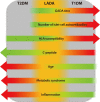Latent Autoimmune Diabetes in Adults: A Review on Clinical Implications and Management
- PMID: 30565440
- PMCID: PMC6300440
- DOI: 10.4093/dmj.2018.0190
Latent Autoimmune Diabetes in Adults: A Review on Clinical Implications and Management
Abstract
Latent autoimmune diabetes in adults (LADA) is a heterogeneous disease characterized by a less intensive autoimmune process and a broad clinical phenotype compared to classical type 1 diabetes mellitus (T1DM), sharing features with both type 2 diabetes mellitus (T2DM) and T1DM. Since patients affected by LADA are initially insulin independent and recognizable only by testing for islet-cell autoantibodies, it could be difficult to identify LADA in clinical setting and a high misdiagnosis rate still remains among patients with T2DM. Ideally, islet-cell autoantibodies screening should be performed in subjects with newly diagnosed T2DM, ensuring a closer monitoring of those resulted positive and avoiding treatment of hyperglycaemia which might increase the rate of β-cells loss. Thus, since the autoimmune process in LADA seems to be slower than in classical T1DM, there is a wider window for new therapeutic interventions that may slow down β-cell failure. This review summarizes the current understanding of LADA, by evaluating data from most recent studies, the actual gaps in diagnosis and management. Finally, we critically highlight and discuss novel findings and future perspectives on the therapeutic approach in LADA.
Keywords: Diabetes mellitus, type 1; Hypoglycemic agents; Insulin; Insulin resistance; Insulin-secreting cells; Latent autoimmune diabetes in adults.
Copyright © 2018 Korean Diabetes Association.
Conflict of interest statement
No potential conflict of interest relevant to this article was reported.
Figures


Similar articles
-
Fatty Acid Profiles and Their Association With Autoimmunity, Insulin Sensitivity and β Cell Function in Latent Autoimmune Diabetes in Adults.Front Endocrinol (Lausanne). 2022 Jun 29;13:916981. doi: 10.3389/fendo.2022.916981. eCollection 2022. Front Endocrinol (Lausanne). 2022. PMID: 35846301 Free PMC article.
-
Latent autoimmune diabetes in adults is perched between type 1 and type 2: evidence from adults in one region of Spain.Diabetes Metab Res Rev. 2013 Sep;29(6):446-51. doi: 10.1002/dmrr.2411. Diabetes Metab Res Rev. 2013. PMID: 23483713
-
Adult-onset autoimmune diabetes: current knowledge and implications for management.Nat Rev Endocrinol. 2017 Nov;13(11):674-686. doi: 10.1038/nrendo.2017.99. Epub 2017 Sep 8. Nat Rev Endocrinol. 2017. PMID: 28885622 Review.
-
Adult-onset autoimmune diabetes: comparative analysis of classical and latent presentation.Diabetol Metab Syndr. 2020 Dec 3;12(1):107. doi: 10.1186/s13098-020-00616-1. Diabetol Metab Syndr. 2020. PMID: 33292447 Free PMC article.
-
Latent Autoimmune Diabetes in Adults: Current Status and New Horizons.Endocrinol Metab (Seoul). 2018 Jun;33(2):147-159. doi: 10.3803/EnM.2018.33.2.147. Endocrinol Metab (Seoul). 2018. PMID: 29947172 Free PMC article. Review.
Cited by
-
A Review on Latent Autoimmune Diabetes in Adults.Cureus. 2023 Oct 29;15(10):e47915. doi: 10.7759/cureus.47915. eCollection 2023 Oct. Cureus. 2023. PMID: 38034250 Free PMC article. Review.
-
Ensemble machine learning reveals key features for diabetes duration from electronic health records.PeerJ Comput Sci. 2024 Feb 26;10:e1896. doi: 10.7717/peerj-cs.1896. eCollection 2024. PeerJ Comput Sci. 2024. PMID: 38435625 Free PMC article.
-
Effects of Bacillus Calmette-Guérin on immunometabolism, microbiome and liver diseases⋆.Liver Res. 2023 Jun;7(2):116-123. doi: 10.1016/j.livres.2023.05.001. Epub 2023 May 19. Liver Res. 2023. PMID: 38223885 Free PMC article.
-
The Influence of Type 2 Diabetes-Associated Factors on Type 1 Diabetes.Diabetes Care. 2019 Aug;42(8):1357-1364. doi: 10.2337/dc19-0102. Epub 2019 Jun 4. Diabetes Care. 2019. PMID: 31167894 Free PMC article.
-
Lifestyle or Environmental Influences and Their Interaction With Genetic Susceptibility on the Risk of LADA.Front Endocrinol (Lausanne). 2022 Jun 29;13:917850. doi: 10.3389/fendo.2022.917850. eCollection 2022. Front Endocrinol (Lausanne). 2022. PMID: 35846274 Free PMC article. Review.
References
-
- Mishra R, Hodge KM, Cousminer DL, Leslie RD, Grant SFA. A global perspective of latent autoimmune diabetes in adults. Trends Endocrinol Metab. 2018;29:638–650. - PubMed
-
- Tuomi T, Groop LC, Zimmet PZ, Rowley MJ, Knowles W, Mackay IR. Antibodies to glutamic acid decarboxylase reveal latent autoimmune diabetes mellitus in adults with a non-insulin-dependent onset of disease. Diabetes. 1993;42:359–362. - PubMed
-
- Hawa MI, Kolb H, Schloot N, Beyan H, Paschou SA, Buzzetti R, Mauricio D, De Leiva A, Yderstraede K, Beck-Neilsen H, Tuomilehto J, Sarti C, Thivolet C, Hadden D, Hunter S, Schernthaner G, Scherbaum WA, Williams R, Brophy S, Pozzilli P, Leslie RD Action LADA consortium. Adult-onset autoimmune diabetes in Europe is prevalent with a broad clinical phenotype: Action LADA 7. Diabetes Care. 2013;36:908–913. - PMC - PubMed
Publication types
LinkOut - more resources
Full Text Sources
Other Literature Sources

